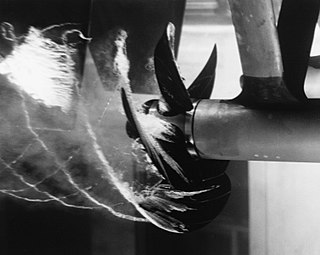
Cavitation is a phenomenon in which the static pressure of a liquid reduces to below the liquid's vapour pressure, leading to the formation of small vapor-filled cavities in the liquid. When subjected to higher pressure, these cavities, called "bubbles" or "voids", collapse and can generate shock waves that may damage machinery. These shock waves are strong when they are very close to the imploded bubble, but rapidly weaken as they propagate away from the implosion. Cavitation is a significant cause of wear in some engineering contexts. Collapsing voids that implode near to a metal surface cause cyclic stress through repeated implosion. This results in surface fatigue of the metal, causing a type of wear also called "cavitation". The most common examples of this kind of wear are to pump impellers, and bends where a sudden change in the direction of liquid occurs. Cavitation is usually divided into two classes of behavior: inertial cavitation and non-inertial cavitation.
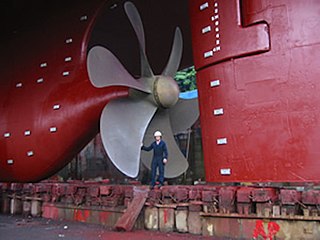
A propeller is a device with a rotating hub and radiating blades that are set at a pitch to form a helical spiral which, when rotated, exerts linear thrust upon a working fluid such as water or air. Propellers are used to pump fluid through a pipe or duct, or to create thrust to propel a boat through water or an aircraft through air. The blades are shaped so that their rotational motion through the fluid causes a pressure difference between the two surfaces of the blade by Bernoulli's principle which exerts force on the fluid. Most marine propellers are screw propellers with helical blades rotating on a propeller shaft with an approximately horizontal axis.

Supercavitation is the use of a cavitation bubble to reduce skin friction drag on a submerged object and enable high speeds. Applications include torpedoes and propellers, but in theory, the technique could be extended to an entire underwater vessel.
In continuum mechanics, the Froude number is a dimensionless number defined as the ratio of the flow inertia to the external field. The Froude number is based on the speed–length ratio which he defined as:
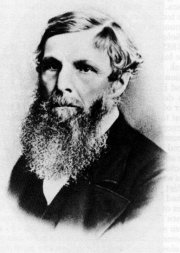
William Froude was an English engineer, hydrodynamicist and naval architect. He was the first to formulate reliable laws for the resistance that water offers to ships and for predicting their stability.

A bulbous bow is a protruding bulb at the bow of a ship just below the waterline. The bulb modifies the way the water flows around the hull, reducing drag and thus increasing speed, range, fuel efficiency, and stability. Large ships with bulbous bows generally have twelve to fifteen percent better fuel efficiency than similar vessels without them. A bulbous bow also increases the buoyancy of the forward part and hence reduces the pitching of the ship to a small degree.

The Australian Maritime College (AMC) is a tertiary education institution based in Launceston, Tasmania, established by the Maritime College Act 1978 (Cth). Tertiary education is provided and organised by the University of Tasmania (UTAS) as the Australian Maritime College at the University of Tasmania (AMC@UTAS). However the college's educational curriculum is governed by the independent AMC Board. The AMC is Australia's national centre for maritime education, training and research. It has two campuses located within 50 kilometres (31 mi) of each other in Northern Tasmania, each with different facilities and residence.

A water tunnel is an experimental facility used for testing the hydrodynamic behavior of submerged bodies in flowing water. It functions similar to a recirculating wind tunnel, but uses water as the working fluid, and related phenomena are investigated, such as measuring the forces on scale models of submarines or lift and drag on hydrofoils. Water tunnels are sometimes used in place of wind tunnels to perform measurements because techniques like particle image velocimetry (PIV) are easier to implement in water. For many cases as long as the Reynolds number is equivalent, the results are valid, whether a submerged water vehicle model is tested in air or an aerial vehicle is tested in water. For low Reynolds number flows, tunnels can be made to run oil instead of water. The advantage is that the increased viscosity will allow the flow to be a faster speed for a lower Reynolds number.

In marine engineering, a ship motion test is hydrodynamic test performed with ship models for the purpose of designing a new ship, or refining the design of a ship to improve its performance at sea. Tests are carried out in a ship model basin or "towing tank". There are various types of test: the model may be towed along a straight line or circular path, and may be subjected to oscillations. Forces acting on the vessel are measured using a dynamometer. The tests may be evaluating the overall design, or focusing on the characteristics of a propeller.

William Denny and Brothers Limited, often referred to simply as Denny, was a Scottish shipbuilding company.
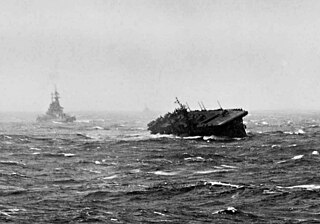
Ship motions are defined by the six degrees of freedom that a ship, boat or any other craft can experience.
A ship must be designed to move efficiently through the water with a minimum of external force. For thousands of years ship designers and builders of sailing vessels used rules of thumb based on the midship-section area to size the sails for a given vessel. The hull form and sail plan for the clipper ships, for example, evolved from experience, not from theory. It was not until the advent of steam power and the construction of large iron ships in the mid-19th century that it became clear to ship owners and builders that a more rigorous approach was needed.
An ice tank is a ship model basin whose purpose is to provide a physical modeling environment for the interaction of ship, structures, or sea floor with both ice and water. Ice tanks may take the form of either a towing tank or maneuvering basin.

MARIN, the Maritime Research Institute Netherlands, is one of the leading institutes in the world for hydrodynamic research and maritime technology. The services incorporate a unique combination of simulation, model testing, full-scale measurements and training programmes. MARIN provides services to the shipbuilding and offshore industry and governments. Customers include commercial ship builders, fleet owners, naval architects, classification societies, oil and LNG companies and navies all over the world.
Dr. William B. Morgan is an American naval architect and renowned expert in propeller design.

The Emerson Cavitation Tunnel is a propeller testing facility that is part of the School of Engineering at Newcastle University.
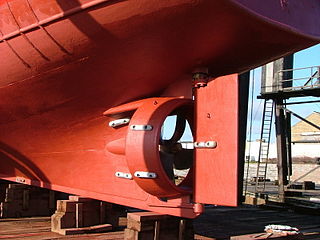
A ducted propeller, also known as a Kort nozzle, is a marine propeller fitted with a non-rotating nozzle. It is used to improve the efficiency of the propeller and is especially used on heavily loaded propellers or propellers with limited diameter. It was developed first by Luigi Stipa (1931) and later by Ludwig Kort (1934). The Kort nozzle is a shrouded propeller assembly for marine propulsion. The cross-section of the shroud has the form of a foil, and the shroud can offer hydrodynamic advantages over bare propellers, under certain conditions.

The Garfield Thomas Water Tunnel is one of the U.S. Navy's principal experimental hydrodynamic research facilities and is operated by the Penn State Applied Research Laboratory. The facility was completed and entered operation in 1949. The facility is named after Lieutenant W. Garfield Thomas Jr., a Penn State journalism graduate who was killed in World War II. For a long time, the Garfield Thomas Water Tunnel was the largest circulating water tunnel in the world. It has been declared a historic mechanical engineering landmark by the American Society of Mechanical Engineers.

The Admiralty Experiment Works (AEW) was the British Admiralty research establishment, responsible for improving propeller design, manoeuvrability and seakeeping in Royal Navy vessels. The Experiment Works existed from 1872 to 1977 and for most of its history was based at the Haslar Gunboat Yard in Gosport, South Hampshire. It ceased independent operations in 1977, merging with the Admiralty Marine Technology Establishment and ultimately with the Defence Research Agency in the Ministry of Defence.






















